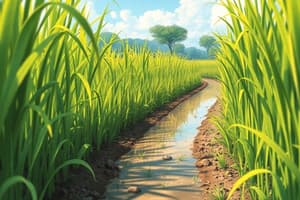Podcast
Questions and Answers
What is a potential disadvantage of broadcast spreading as a fertilizer application method?
What is a potential disadvantage of broadcast spreading as a fertilizer application method?
- Precise application near plant roots
- Deep injection of liquids below ground level
- Reduced nutrient loss due to runoff
- Uneven distribution of nutrients (correct)
How does band placement differ from broadcast spreading as a fertilizer application method?
How does band placement differ from broadcast spreading as a fertilizer application method?
- Bands cause wasteful overspray and uneven distribution
- Broadcast spreading covers small strips beside plant rows
- Bands target roots directly and require less material (correct)
- Broadcast spreading is more precise and efficient
What advantage do injection systems offer over broadcast spreading and band placement?
What advantage do injection systems offer over broadcast spreading and band placement?
- Reducing nutrient loss due to wasteful overspray
- Scattering fertilizers evenly using rotary spreaders
- Injecting liquids deep below ground level for natural absorption (correct)
- Even distribution of nutrients across large areas
Which factor is important to consider when choosing a fertilizer application method?
Which factor is important to consider when choosing a fertilizer application method?
How do precision farming technologies enhance fertilizer application accuracy?
How do precision farming technologies enhance fertilizer application accuracy?
Why is making informed decisions about fertilizer selection and application important?
Why is making informed decisions about fertilizer selection and application important?
What is the first step recommended before applying any type of fertilizer?
What is the first step recommended before applying any type of fertilizer?
Which type of soil might benefit from organic matter amendment for improved water retention?
Which type of soil might benefit from organic matter amendment for improved water retention?
How do organic fertilizers differ from inorganic fertilizers in terms of nutrient release?
How do organic fertilizers differ from inorganic fertilizers in terms of nutrient release?
Which type of soil condition might require lime applications?
Which type of soil condition might require lime applications?
Why is it important to know the distinct requirements of each agricultural setting before fertilizing crops?
Why is it important to know the distinct requirements of each agricultural setting before fertilizing crops?
What should sandy soils be amended with to improve water retention?
What should sandy soils be amended with to improve water retention?
Flashcards are hidden until you start studying
Study Notes
Cultivating Plentiful Harvests through Smart Fertilizer Management
Modern agriculture thrives on our ability to sustainably produce food for growing populations while minimizing environmental impacts. One of the cornerstones of achieving this goal is optimized crop production and careful management of nutrient inputs, particularly by employing strategic fertilization techniques. Here we'll explore various approaches to fertilize crops efficiently, ensuring their healthy growth and ultimately, maximizing yield.
Soil Testing and Nutrient Recommendations
Before applying any type of fertilizer, it's vital to understand the soil's current nutritional state via routine testing. This data helps determine which elements need boosting, how much, and what form is most effective. Each region and unique agricultural setting may have distinct requirements. For instance, acidic soils often require lime applications; sandy soils might benefit from organic matter amendment to improve water retention; whereas high salt concentrations call for leaching or irrigation adjustments.
Organic vs. Inorganic Fertilizers
Fertilizers can broadly be divided into two categories – organic (derived mainly from plant and animal sources) and inorganic (chemical compounds). Both have pros and cons. Organic materials tend to break down more slowly, releasing nutrients steadily over time without causing rapid spikes that could burn plants. On the other hand, they generally contain lower quantities of essential nutrients per unit weight compared with chemical counterparts. Conversely, synthetic options offer immediate availability and higher concentrations of specific nutrients, yet also pose potential risks regarding pollution and ecosystem disruption.
Fertilizer Application Methods
With numerous application techniques available, choosing the right one involves considering factors such as uniformity, efficiency, and cost. Some popular methods include broadcast spreading, band placement, and injection systems:
- Broadcast Spreading: With this widely used method, both solid and liquid fertilizers are scattered evenly across fields using equipment like rotary spreaders or airplanes. While convenient and relatively affordable, this technique isn’t always precise and sometimes causes wasteful overspray and uneven distribution.
- Band Placement: Instead of covering large areas, bands place small strips of fertilizer beside plant rows. By targeting roots directly, less material is required, and nutrient loss due to runoff and volatility is reduced.
- Injection Systems: Utilizing specialized machinery, these systems inject liquids deep below ground level where they dissolve naturally before being absorbed by plant roots.
Precision Agriculture
Precision farming technologies have emerged, revolutionizing traditional agronomic practices and enhancing accuracy during fertilizer application stages. Employing tools such as GPS-guided tractors, variable rate technology (VRT), satellite imagery, and sensors help farmers apply exactly the correct amount of nutrients to each part of their field based upon identified variations in soil types, topography, and crop needs. These advanced strategies minimize costs and environmental harm by reducing unnecessary usage of resources.
In conclusion, making informed decisions when selecting fertilizer types and application styles is crucial to achieving optimal yields while protecting the environment. As global demand for food continues increasing, embracing smart fertilizer management will become ever more imperative for securing abundant harvests and sustainable futures.
Studying That Suits You
Use AI to generate personalized quizzes and flashcards to suit your learning preferences.




